PECK, STOW & WILCOX CO.
The Peck, Stow & Wilcox Co (P.S. & W.) was organized about 1870 in
Southington, Conn with the merger of three parent companies (Peck, Smith, & Co;
S. Stow Mfg Co, and the Roys & Wilcox Co –Per EAIA DAT*). PS&W quickly grew to
be a giant in the tool and hardware business, surviving at least to 1950 when it
was acquired by Billings & Spencer. Outside of a widely available 1927 catalogue
reprint, there seems to be little information available about the company’s
products, especially between 1870 and 1900. In their later advertising, P.S. &
W. claimed to have produced the first "brace made in American in 1850" – clearly
a claim made in the great advertising tradition of smoke blowing.
P.S. & W. produced a line of braces from about 1880 that were of very high
quality and quite distinctive—having interlocking jaws and a ratcheting
mechanism that was unique to these braces. After 1895 their brace line expanded
and included a ball bearing, universal jaw chuck ("Samson") that
predated the "Lion" chuck of Millers Falls.
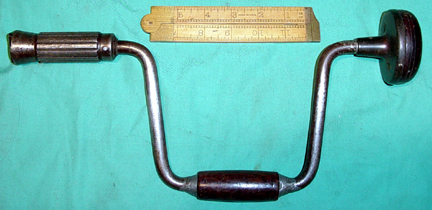 What I judge to be the earliest P.S. & W. brace in my collection is this
sleeve (no ratchet) brace with an interlocking jaw chuck. The lower bow on this
brace is marked with the patent date, Feb. 11, 1879 and "No. 92." The patent is
one issued to Obed Peck and D. Powers for a chuck with interlocking jaws that
are grooved on their bases to fit with threads on the inside of the chuck shell
(Obed Peck does not seem to be related to Seth Peck, who is the "Peck" in the
company name). This patent appears on later braces by P.S.&W. and apparently was
their basic chuck. This brace differs from later ones by having a chuck shell
that is not knurled, but has longitudinal grooves on its outer surface. Also the
cup handle is fastened to the underlying fully clad quill by two screws that are
fitted by bolt heads on the top of the decorated cocobolo handle. This feature
disappears in later braces.
What I judge to be the earliest P.S. & W. brace in my collection is this
sleeve (no ratchet) brace with an interlocking jaw chuck. The lower bow on this
brace is marked with the patent date, Feb. 11, 1879 and "No. 92." The patent is
one issued to Obed Peck and D. Powers for a chuck with interlocking jaws that
are grooved on their bases to fit with threads on the inside of the chuck shell
(Obed Peck does not seem to be related to Seth Peck, who is the "Peck" in the
company name). This patent appears on later braces by P.S.&W. and apparently was
their basic chuck. This brace differs from later ones by having a chuck shell
that is not knurled, but has longitudinal grooves on its outer surface. Also the
cup handle is fastened to the underlying fully clad quill by two screws that are
fitted by bolt heads on the top of the decorated cocobolo handle. This feature
disappears in later braces.
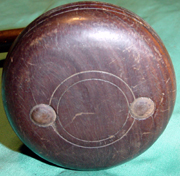
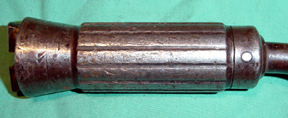
I remember seeing only a few of these early non-ratcheting braces —although a couple of models are offered in the 1927 catalogue.
One sleeve brace in my collection features jaws also patented by
Obed Peck, in 1881.
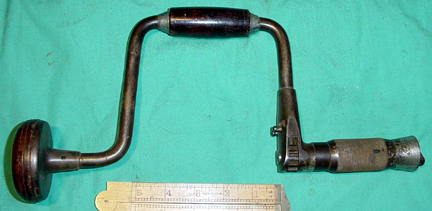 The earliest
ratcheting P.S. & W. braces in my collection are those with the same 1879 patent
data stamped on the lower bow, and a December 30, 1884 patent date stamped in
the top of the ratchet housing. There are three brace patents listed on this date
(only two of which are in Pearson), but the most likely is the one issued to
Caspar Reising (No. 309,876) which included pin selectors
to alter the ratchet setting. George Langford was diligent enough to ferret this
patent out, and pass the information along. The braces marked with this patent have two
selector pins protruding from the top of the ratchet housing. Each of these
moves the ratchet dog to engage or disengage the ratchet gear. Braces of this
type have double knurled chuck shells, and the fully clad, decorated cocobolo
handles are fastened with three screws through the quill flange that do not
engage exposed bolt heads on the top. Representative braces include one with 8"
sweep marked "No. 103"; and 10" sweep marked "No. 102."
Chuck Zitur owns a 1911 P.S.&W. catalogue in which the pin ratchet selector
still appears (Per. Comm).
The earliest
ratcheting P.S. & W. braces in my collection are those with the same 1879 patent
data stamped on the lower bow, and a December 30, 1884 patent date stamped in
the top of the ratchet housing. There are three brace patents listed on this date
(only two of which are in Pearson), but the most likely is the one issued to
Caspar Reising (No. 309,876) which included pin selectors
to alter the ratchet setting. George Langford was diligent enough to ferret this
patent out, and pass the information along. The braces marked with this patent have two
selector pins protruding from the top of the ratchet housing. Each of these
moves the ratchet dog to engage or disengage the ratchet gear. Braces of this
type have double knurled chuck shells, and the fully clad, decorated cocobolo
handles are fastened with three screws through the quill flange that do not
engage exposed bolt heads on the top. Representative braces include one with 8"
sweep marked "No. 103"; and 10" sweep marked "No. 102."
Chuck Zitur owns a 1911 P.S.&W. catalogue in which the pin ratchet selector
still appears (Per. Comm).
.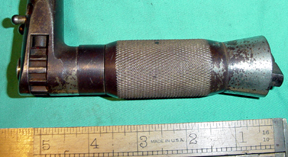
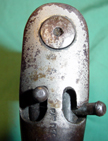
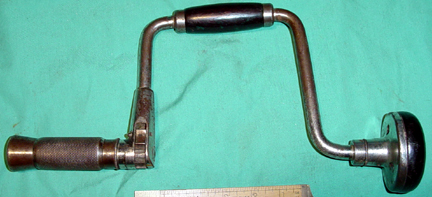 Slightly
later braces appear in which the 1879 patent date remains on the bow, but the
1884 date is no longer carried.. These braces use a ratchet selector system that requires
manually flipping the ratchet dogs from either side of the exposed ratchet gear. .
Apparently the pin selector system was unwieldy. The new ratchet is quite
similar to that patented on Feb 19, 1884 by R.C. Ellrich (#293957), but is not
marked as such.. Representatives of this type of
selector are found on my braces that include a 12" brace marked, "No 1001" and a
10" brace marked "No 1002," and 14" brace marked, "1200.""The latter
two braces do not carry the 1879 patent date
(which probably expired). They have other features that look later. For example the
wrist handle is positioned by steel retainer rings that are screwed to the frame
(the earlier braces have cast pewter retainer rings) and there is less
decoration on the cocobolo cup handle). The 14" brace is equipped
with a "Samson" chuck having an 1895 patent date.
Slightly
later braces appear in which the 1879 patent date remains on the bow, but the
1884 date is no longer carried.. These braces use a ratchet selector system that requires
manually flipping the ratchet dogs from either side of the exposed ratchet gear. .
Apparently the pin selector system was unwieldy. The new ratchet is quite
similar to that patented on Feb 19, 1884 by R.C. Ellrich (#293957), but is not
marked as such.. Representatives of this type of
selector are found on my braces that include a 12" brace marked, "No 1001" and a
10" brace marked "No 1002," and 14" brace marked, "1200.""The latter
two braces do not carry the 1879 patent date
(which probably expired). They have other features that look later. For example the
wrist handle is positioned by steel retainer rings that are screwed to the frame
(the earlier braces have cast pewter retainer rings) and there is less
decoration on the cocobolo cup handle). The 14" brace is equipped
with a "Samson" chuck having an 1895 patent date.
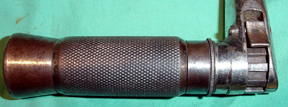
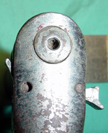
The final major improvement made in the P.S. & W. braces before 1900 was the
development of the "Samson" chuck. This had a ball bearing chuck shell with an
extended knurled section for ease in tightening the bit in place, and a pair of
extended alligator jaws with parallel faces and a cutout in them for the tang of
a bit. This premium chuck was designed to hold round as well as tanged bits. Its
development occurred with the July 9, 1895 patent of Henry Smith of Hartford,
Conn. (#542448). Ron Pearson gives this an "A" rarity value, yet it is the basis
of the very popular and successful chuck. The Samson chuck is equivalent in
function to Millers Falls’ "Lion" chuck (and pre-dated it). Those P.S. & W
braces having it are considered among the best braces ever manufactured.
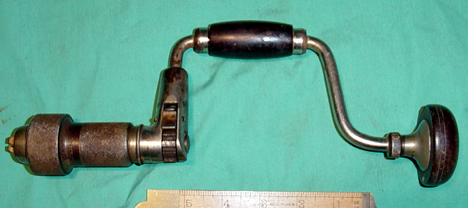
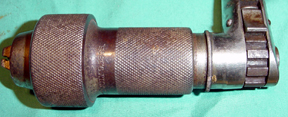 The brace above
is fitted with an early "Samson" chuck (that has the patent date stamped on it).
Note that this brace, in the uncommon 6" sweep, has the exposed manual ratchet
dogs and screw-fastened wrist handle retainers. Dating to about 1900, this brace
is numbered, 1204. It has two P.S.&W marks—the older "P.S.&W. Co." mark and the
newer one featuring a hand with cold chisel in a circle, with "P.S. & W.,
Guaranteed" around the circle. The latter logo was replaced by 1927 with "Pexto"
in an oval, surrounded by "Southington, Conn. USA".
The brace above
is fitted with an early "Samson" chuck (that has the patent date stamped on it).
Note that this brace, in the uncommon 6" sweep, has the exposed manual ratchet
dogs and screw-fastened wrist handle retainers. Dating to about 1900, this brace
is numbered, 1204. It has two P.S.&W marks—the older "P.S.&W. Co." mark and the
newer one featuring a hand with cold chisel in a circle, with "P.S. & W.,
Guaranteed" around the circle. The latter logo was replaced by 1927 with "Pexto"
in an oval, surrounded by "Southington, Conn. USA".
The brace below carries that PEXTO mark, along with the name "Samson" on
both the brace and the chuck. This 12" brace is numbered 8012B and was near the
top of P.S.&W’s brace line in its day. It still is an excellent brace. Note that
the ratchet selector has been changed to the ring type, used for much longer by
Millers Falls. Also, by the 1920’s most of P.S.&W.’s lower quality braces were
equipped with Barber Improved type chucks and those with interlocking jaws had
all but been phased out.
.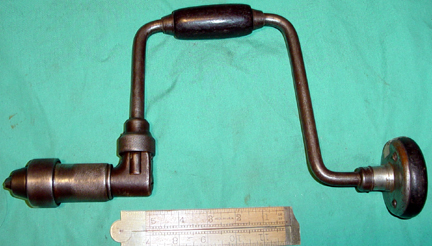
As a major manufacturer of quality braces during the first half
of the 20th Century, P.S.&W. also provided braces to some major retail concerns.
Most notably the braces marked, "Worth" and marketed through the Bigelow & Dowes
Co. of Boston were probably made by P.S.&W. and are generally of quite high
quality. P.S.&W. also is known to have made braces marked as "Keen Kutter"
for the A.E. Simmons Co. of St. Louis.
Return to Brace INDEX
* 1999 - Directory of American Toolmakers. Robert E.
Nelson, Editor. Early American Industries Association (EAIA). 1176
pp.
 What I judge to be the earliest P.S. & W. brace in my collection is this
sleeve (no ratchet) brace with an interlocking jaw chuck. The lower bow on this
brace is marked with the patent date, Feb. 11, 1879 and "No. 92." The patent is
one issued to Obed Peck and D. Powers for a chuck with interlocking jaws that
are grooved on their bases to fit with threads on the inside of the chuck shell
(Obed Peck does not seem to be related to Seth Peck, who is the "Peck" in the
company name). This patent appears on later braces by P.S.&W. and apparently was
their basic chuck. This brace differs from later ones by having a chuck shell
that is not knurled, but has longitudinal grooves on its outer surface. Also the
cup handle is fastened to the underlying fully clad quill by two screws that are
fitted by bolt heads on the top of the decorated cocobolo handle. This feature
disappears in later braces.
What I judge to be the earliest P.S. & W. brace in my collection is this
sleeve (no ratchet) brace with an interlocking jaw chuck. The lower bow on this
brace is marked with the patent date, Feb. 11, 1879 and "No. 92." The patent is
one issued to Obed Peck and D. Powers for a chuck with interlocking jaws that
are grooved on their bases to fit with threads on the inside of the chuck shell
(Obed Peck does not seem to be related to Seth Peck, who is the "Peck" in the
company name). This patent appears on later braces by P.S.&W. and apparently was
their basic chuck. This brace differs from later ones by having a chuck shell
that is not knurled, but has longitudinal grooves on its outer surface. Also the
cup handle is fastened to the underlying fully clad quill by two screws that are
fitted by bolt heads on the top of the decorated cocobolo handle. This feature
disappears in later braces.

 The earliest
ratcheting P.S. & W. braces in my collection are those with the same 1879 patent
data stamped on the lower bow, and a December 30, 1884 patent date stamped in
the top of the ratchet housing. There are three brace patents listed on this date
(only two of which are in Pearson), but the most likely is the one issued to
Caspar Reising (No. 309,876) which included pin selectors
to alter the ratchet setting. George Langford was diligent enough to ferret this
patent out, and pass the information along. The braces marked with this patent have two
selector pins protruding from the top of the ratchet housing. Each of these
moves the ratchet dog to engage or disengage the ratchet gear. Braces of this
type have double knurled chuck shells, and the fully clad, decorated cocobolo
handles are fastened with three screws through the quill flange that do not
engage exposed bolt heads on the top. Representative braces include one with 8"
sweep marked "No. 103"; and 10" sweep marked "No. 102."
Chuck Zitur owns a 1911 P.S.&W. catalogue in which the pin ratchet selector
still appears (Per. Comm).
The earliest
ratcheting P.S. & W. braces in my collection are those with the same 1879 patent
data stamped on the lower bow, and a December 30, 1884 patent date stamped in
the top of the ratchet housing. There are three brace patents listed on this date
(only two of which are in Pearson), but the most likely is the one issued to
Caspar Reising (No. 309,876) which included pin selectors
to alter the ratchet setting. George Langford was diligent enough to ferret this
patent out, and pass the information along. The braces marked with this patent have two
selector pins protruding from the top of the ratchet housing. Each of these
moves the ratchet dog to engage or disengage the ratchet gear. Braces of this
type have double knurled chuck shells, and the fully clad, decorated cocobolo
handles are fastened with three screws through the quill flange that do not
engage exposed bolt heads on the top. Representative braces include one with 8"
sweep marked "No. 103"; and 10" sweep marked "No. 102."
Chuck Zitur owns a 1911 P.S.&W. catalogue in which the pin ratchet selector
still appears (Per. Comm).

 Slightly
later braces appear in which the 1879 patent date remains on the bow, but the
1884 date is no longer carried.. These braces use a ratchet selector system that requires
manually flipping the ratchet dogs from either side of the exposed ratchet gear. .
Apparently the pin selector system was unwieldy. The new ratchet is quite
similar to that patented on Feb 19, 1884 by R.C. Ellrich (#293957), but is not
marked as such.. Representatives of this type of
selector are found on my braces that include a 12" brace marked, "No 1001" and a
10" brace marked "No 1002," and 14" brace marked, "1200.""The latter
two braces do not carry the 1879 patent date
(which probably expired). They have other features that look later. For example the
wrist handle is positioned by steel retainer rings that are screwed to the frame
(the earlier braces have cast pewter retainer rings) and there is less
decoration on the cocobolo cup handle). The 14" brace is equipped
with a "Samson" chuck having an 1895 patent date.
Slightly
later braces appear in which the 1879 patent date remains on the bow, but the
1884 date is no longer carried.. These braces use a ratchet selector system that requires
manually flipping the ratchet dogs from either side of the exposed ratchet gear. .
Apparently the pin selector system was unwieldy. The new ratchet is quite
similar to that patented on Feb 19, 1884 by R.C. Ellrich (#293957), but is not
marked as such.. Representatives of this type of
selector are found on my braces that include a 12" brace marked, "No 1001" and a
10" brace marked "No 1002," and 14" brace marked, "1200.""The latter
two braces do not carry the 1879 patent date
(which probably expired). They have other features that look later. For example the
wrist handle is positioned by steel retainer rings that are screwed to the frame
(the earlier braces have cast pewter retainer rings) and there is less
decoration on the cocobolo cup handle). The 14" brace is equipped
with a "Samson" chuck having an 1895 patent date.


 The brace above
is fitted with an early "Samson" chuck (that has the patent date stamped on it).
Note that this brace, in the uncommon 6" sweep, has the exposed manual ratchet
dogs and screw-fastened wrist handle retainers. Dating to about 1900, this brace
is numbered, 1204. It has two P.S.&W marks—the older "P.S.&W. Co." mark and the
newer one featuring a hand with cold chisel in a circle, with "P.S. & W.,
Guaranteed" around the circle. The latter logo was replaced by 1927 with "Pexto"
in an oval, surrounded by "Southington, Conn. USA".
The brace above
is fitted with an early "Samson" chuck (that has the patent date stamped on it).
Note that this brace, in the uncommon 6" sweep, has the exposed manual ratchet
dogs and screw-fastened wrist handle retainers. Dating to about 1900, this brace
is numbered, 1204. It has two P.S.&W marks—the older "P.S.&W. Co." mark and the
newer one featuring a hand with cold chisel in a circle, with "P.S. & W.,
Guaranteed" around the circle. The latter logo was replaced by 1927 with "Pexto"
in an oval, surrounded by "Southington, Conn. USA". 